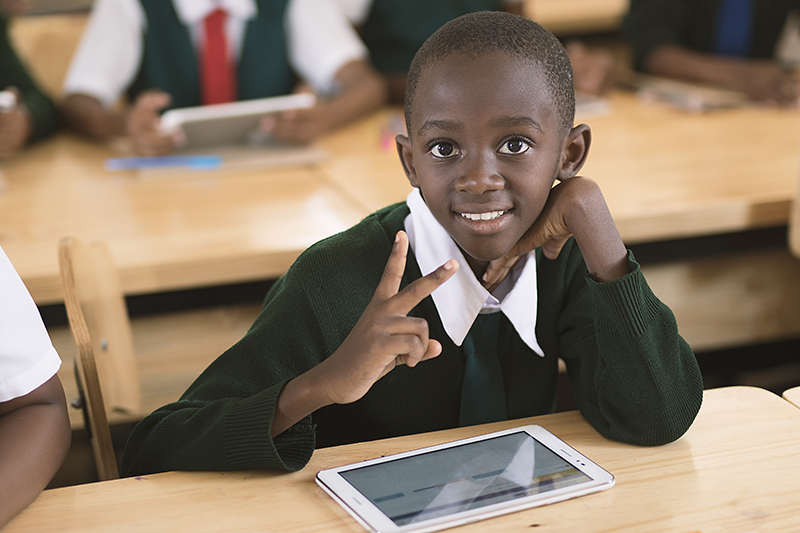
The spread of digital technologies into everyday life has sparked one of the most intense debates in contemporary education: should schools allow or ban screen use? Reducing the answer to this question to a simple yes or no may be as naïve as it is counterproductive. As we previously argued in the article “The false debate about technology in the classroom,” the key issue is not whether technology should exist in the classroom, but how and why we use it.
From this perspective, this article compiles the arguments of specialists who call for a much more nuanced approach: one that promotes critical, inclusive and pedagogically meaningful use of technology in schools.
A pedagogy for a digital society
Rather than questioning the legitimacy of screen use in and of itself, many experts propose revisiting how teaching and learning are carried out in a digital society. It is not merely about incorporating technological tools, but about building a pedagogy consistent with contemporary ways of accessing knowledge, communicating and creating.
In this sense, Carlos Magro, an expert in educational innovation, argues that “educational technology has become an ecosystem that redefines teaching and learning processes, and that schools must integrate it consciously and critically.” Instead of an education based on repetition and one-way content transmission, he proposes fostering critical thinking, collaborative work and meaningful learning, in line with the opportunities offered by digital tools.
This perspective aligns with the socio-constructivist pedagogical approach, which emphasises student activity, situated learning and working on real-world problems. In digital contexts, this means designing learning experiences that integrate technology not as an end in itself, but as a means to develop complex cognitive, social and communicative skills.
Along the same lines, Laura Cuesta argues that “educational technology is not about replacing a book with a tablet, but about transforming the educational experience.” What matters is not the medium, but the methodology, the educational intent, and the kind of relationship created between educational actors.
Therefore, the question is not whether we should use technology in the classroom, but how to design learning environments that promote active and reflective digital citizenship. This view is aligned with the European Union’s key competences approach and with frameworks such as DigCompEdu, which outlines the essential digital competences for teachers and promotes the critical and effective integration of technology into educational practice.
Banning screens in classrooms directly contradicts the spirit of this European framework, which does not advocate indiscriminate use of technology, but rather its critical and effective integration to help form students capable of functioning in a digital society. If devices are banned, the development of absolutely essential skills is halted in its tracks, ignoring the spirit of a model that not only invites screen use, but also encourages understanding, regulating and leveraging it in favour of richer, more relevant learning.
Techno-pedagogical arguments: critical literacy and skills for the present
Far from being an enemy of learning, numerous experts highlight how technology can become a powerful ally if integrated with clear pedagogical criteria. In this regard, the paediatric neurologist María José Mas states in an interview with the newspaper El Español that “the problem is not the screen, but the content and the context” — that is, teaching the correct use of technology matters more than limiting screen time. Thus, instead of excluding technology, she advocates for its inclusion (for example, learning to use word processors or AI) alongside exercises like dictation and handwriting.
This idea aligns with Richard Mayer’s studies on multimedia learning, which show that, when properly designed, digital environments can enhance understanding, retention and knowledge transfer.
In this Education Next article, educational innovation expert Michael B. Horn adds another argument in favour, pointing out that digital devices allow for personalised teaching adapted to each student’s pace, which is particularly helpful for those with difficulties or diverse learning styles. Banning them, on the other hand, standardises teaching and limits the inclusive potential of technology.
Philosopher Gregorio Luri puts it succinctly: “Do we want to be a digitally competent society? If the answer is yes, then we must educate from the outset in the digital world.” From this viewpoint, the pedagogical question is not about saying yes or no to technology, but about how to form critical, autonomous individuals capable of thinking with and about technology.
Carlos Magro reminds us that educational technology must be understood, interrogated, and pedagogically regulated. Generative artificial intelligence is a clear example. If students do not understand the purpose of a school task, they will use AI as a shortcut. That is why, in addition to rethinking the purpose of schooling, it is essential to have a conversation about artificial intelligence. The response, he argues, cannot be to ban it, but to clarify the value of each task, integrate these tools into the curriculum design, and teach their critical use.
Former school principal Brandon Cardet-Hernández agrees that banning devices disconnects schools from the digital reality of their students. Instead of ignoring this reality, we should harness its potential to learn how to learn, search, create, contrast and engage in dialogue within digital environments.
Banning technology in classrooms is like closing your eyes and hoping the monster disappears: a strategy that only works in children’s stories.
Social arguments: inclusion, equity and the right to learn
From a social perspective, technology is much more than a tool: it is a condition for guaranteeing the right to learn in a digitalised world. Online platforms, digital libraries, educational apps and virtual learning environments expand access to quality content beyond the physical limits of school. This is especially relevant in rural, vulnerable or low-resource contexts, where school may be the only point of contact with the digital world.
Alejandro Artopoulos, Academic Director at the Centre for Pedagogical Innovation at the University of San Andrés, warns that banning screens in schools could deepen existing inequalities, as students without access to technology at home would be doubly excluded. “We live in a platform society. By banning mobile phones, we are raising children who are defenceless in the digital jungle,” he argues, stressing the urgency of digital citizenship education within the school system.
In the same article, Mariana Maggio (University of Buenos Aires) warns that the failure to integrate technologies not only limits access to learning resources, but also creates “invisible expulsions,” leaving behind students without digital access at home. According to Maggio, this technological disconnect seriously jeopardises their continuation into higher education and future employment inclusion.
Gregorio Luri complements this view by highlighting the regressive effects of prohibitionist policies: “Schools that already have resources will continue to use them; those that don’t will fall further behind. And that breaks equity.” Luri warns of the possibility that screen bans may be enforced more strictly in under-resourced schools, creating a double standard that widens the gap between public and private education.
From an educational justice perspective, teaching the critical, safe and responsible use of digital technologies is not optional — it is a public duty. In the 21st century, social inclusion necessarily involves ensuring access to, use of and understanding of digital environments. Denying this reality, or expelling it from the classroom, is also a form of exclusion.
Psychological arguments: teaching how to coexist with the digital world
The discomfort caused by excessive or problematic screen use among children and adolescents is a legitimate concern: sleep disorders, attention difficulties, social anxiety, and digital content addiction are well-documented phenomena. However, a growing number of psychologists, educators and neuroscientists agree that blanket bans are not the appropriate response. The key is not to eliminate technology, but to foster healthy usage habits, develop self-regulation skills, and build meaningful and guided digital environments.
In an interview with the newspaper Portafolio, Marieth Lozano, spokesperson for the Colombian College of Psychologists (Colpsic), states that “mobile phone use should be regulated, not banned.” From this standpoint, the school’s role is to teach students to manage technology, set limits, recognise risks — but also benefits — and make informed decisions. This involves integrating digital literacy, mental health, and emotional wellbeing into the school curriculum.
Gregorio Luri, for his part, suggests that many of today’s fears around screens are not so much grounded in scientific evidence as in poorly channelled collective anxiety: “Banning mobile phones is a cheap measure that promises miraculous results for nervous parents.” In his view, this disproportionate reaction to perceived risks distracts from deeper structural issues affecting young people’s wellbeing, such as overly competitive schooling models, performance pressure, or lack of quality time with significant adults.
Empirical studies reinforce this critical view of prohibitionism. A recent study from the University of Virginia, published in The Lancet Child & Adolescent Health, showed that strict restrictions on smartphone use in classrooms do not improve students’ emotional wellbeing or academic performance on their own. In fact, in some cases they cause frustration, loss of autonomy and difficulties communicating with peers.
Likewise, researchers such as Sonia Livingstone and Danah Boyd have shown that the psychological impact of screen use depends less on the amount of time spent and more on the type of activity, the relational context and adult guidance. It is not the same to passively and solitarily watch videos for hours as to participate in collaborative projects, create content, or solve problems using digital tools in a guided setting.
For this reason, international organisations for child health and wellbeing — such as UNICEF and the American Psychological Association (APA) — recommend promoting a “balanced digital diet” instead of absolute bans. This means teaching digital self-care, recognising signs of saturation or dependency, and encouraging open dialogue among students, teachers and families about technology’s place in daily life.
Educating for digital coexistence means teaching how to use technology — but also how to disconnect, how to choose, how to prioritise, and how to set internal and external boundaries wisely. In this sense, the classroom can be a privileged space for modelling healthy and responsible practices. Removing technology from that space would be sheer madness: it would mean giving up one of the few places where its use can be accompanied, reflected upon, and transformed into meaningful learning.
It’s not the screens — it’s how we look at them
The discussion about technology in schools is understandable: it is daunting to think that the world is advancing faster than our ability to comprehend it. But in staring so intently at the screen, we forget to look at what really matters.
The problem isn’t the mobile phone, the tablet, or artificial intelligence. The problem is that schools still try to educate students as if they were living in the 1980s, while they — like it or not — already live in the 21st century. Banning technology in classrooms is like closing your eyes and hoping the monster disappears: a strategy that only works in children’s stories.
Screens, when well used, do not dull minds; they can illuminate. They can connect a student from a vulnerable background with a museum in Amsterdam, or a teacher with new ways of teaching. But that only happens if we teach students how to look. To look with discernment, with pause, with intention. Technology should not be an enemy to defeat, but a language that schools must learn to speak — fluently, and with a pedagogical accent.
Because the true responsibility of education is not to protect students from the world, but to prepare them to live in it. And this world — whether we like it or not — comes with screens built in.






